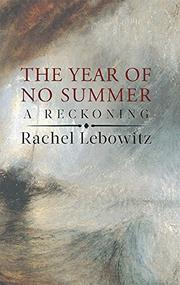Reviewed by Anna Gilgoff
 To characterize Rachel Lebowitz’s The Year of No Summer: A Reckoning (Biblioasis, May 2018) simply as a cautionary tale is to minimize the author’s considerable research abilities and poetic approach in describing a horrific natural event.
To characterize Rachel Lebowitz’s The Year of No Summer: A Reckoning (Biblioasis, May 2018) simply as a cautionary tale is to minimize the author’s considerable research abilities and poetic approach in describing a horrific natural event.
Using the eruption of Indonesia’s Mount Tambora on April 10, 1815, Lebowitz leaps to other events that happened around the earth on or about the same date. The nearly 12,000 people that were killed was not a singular tragic consequence. Weather impacted the events of the following year. There was no summer which led to no crops and massive food shortages affecting human and animal populations throughout the world.
Famine is one of the author’s key concerns, and it surfaces several times throughout the work in devastating detail. In the chapter titled “Medusa,” Lebowitz writes: “People begin to eat their hats or the scabbards of their swords. And it is on the third day that people start on the dead that surround them. Stomach, shoulder, thigh.”
The impact of the eruption on Europe is staggering, including on the swelling of the French population, the rise in bread prices, and the rioting on French streets. In England, the price of wheat “rises 50 % in just a few months” leading to havoc on the streets in the form of pillaging and looting.
Weather patterns are not the only dramatic consequences. The psychological and cultural impact of the eruption on the world is equally dramatic. Lebowitz illustrates this using ancient myths, biblical stories, and contemporary tales. The story of Daedalus, for example, surfaces again and again.
Lebowitz intimates that the eruption of the volcano seeped into the literature of the times. The chapter called “The Children of Famine” is a retelling of a tale she attributes to the Brothers Grimm. Its bleakness strikes the reader from the very start. “Once upon a time, there was a woman who had two daughters, as beautiful as sunshine on snowfall and as lovely as unplucked plums.” Three short paragraphs later, she shows a direr scene. “They ate rotting grain, rotting potatoes, rotting rats.”
Lebowitz has a penchant for showing such reversals of fortune while relating them to the Tambora catastrophe. Another example of this is attributed to “The Snow Queen” by Hans Christian Andersen. “The windows frost over so strangely, looking like flowers” is a lovely image at first but soon comes the realization that “the snowflakes came not from the sky but running along the ground, and the closer they came, the bigger they grew. Some looked like big horrid porcupines, others like giant knobs of snakes with writhing heads, all of them were dazzling white.”
It is arguable if the events Lebowitz refers to are all scientifically connected to the eruption of Mount Tambora, especially those that precede the eruption. Is there a connection between Waterloo and Mount Tambora? She takes artistic license to support her case, if she is actually presenting one. But with descriptions like “Birds dead in the field, a river full of knives. Shorn sheep shiver in summer snow, then stop… The wolves catch up to the sun and moon-this bright sun blackened this bright sun extinguished,” it’s hard to dismiss she isn’t.
Lebowitz is concerned about the future of the environment as we know it. Early in the book, she writes about the poignancy of birth, and the inclination to comparing the growing fetus to maturing fruit. “No one ever says your baby is the size of a bullet. Your baby is now growing to the size of a grenade.” It’s a sobering observation that seems sadly appropriate in today’s times.
There are autobiographical elements in this work. Sporadically, a child appears, asking for explanations. Once he asks, “Mommy, why is the earth always changing?” Leibowitz offers no clear answer. When she picks up her son from daycare he says, “Today I had a hard time staying human.” That seems to resonate in the mother and the reader.
This is not a collection of stories, essays or fairy tales, though it has elements of all three. It is not a scientific treatise, though science features mightily, nor is it a memoir, though her relationship with her son appears at times.
Lebowitz includes 125 footnotes explaining her many references, amounting to 25 pages at the end of this slender work, citing excerpts from Ovid’s Metamorphoses to Burnett’s The Secret Garden. Chapter title such as “Ragnarok,” “Medusa,” and “Daedalus” more than indicate other sources that inform her work.
In presenting a strange world that somehow seems oddly familiar, Lebowitz expresses her fears and issues a warning. But in the end, she remains a cautious optimist confiding her conflicting feelings to her reader. “I have it in me to believe in a goodness that happens most days of the month, though history proves otherwise. I choose not to see this. I minimize the evil or make it predictable with clear warnings, a beacon of soft light.”
Are these words useful in the face of Chernobyl, Katrina, and Sandy? That’s for people and their governments to decide, maybe with Lebowitz’s “beacon of soft light.”


